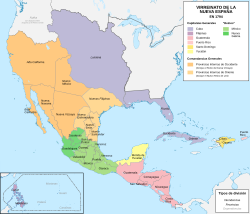New Philippines facts for kids
The New Philippines (also known as Nuevas Filipinas in Spanish) was a large area of land that was part of New Spain. New Spain was a huge territory controlled by Spain in North America, which included much of what is now Mexico and parts of the United States. The full name for this area was Nuevo Reino de Filipinas, which means "New Kingdom of the Philippines."
This land was named to honor Philip V of Spain, who was the King of Spain at the time. The New Philippines stopped being a separate territory in 1821 when New Spain itself came to an end.
Contents
Where Was the New Philippines?
This Spanish territory was in a different place than the country of the Philippines you know today. It was located in North America.
The New Philippines partly covered what is now the U.S. state of Texas. However, its borders were quite different from Texas's current shape. The land was mostly north of the Medina River and Nueces River, which are in South-Central Texas. So, only the central and northern parts of modern Texas were part of the New Philippines.
The Medina River was the official border between the New Philippines and another Spanish province called New Extremadura. To the west, the New Philippines bordered Nueva Vizcaya and Nuevo México. To the north, its border almost reached the Red River. To the east, the border changed over time, first with French lands, then Spanish lands, and finally American lands.
Disputes Over the Eastern Border
There was a long disagreement about where the eastern border of the New Philippines was. France claimed its land reached all the way to the Rio Grande, which would have meant the New Philippines didn't exist at all! Spain, on the other hand, said its eastern border went to the Red River.
To show their claims, the French built a settlement called Natchitoches in 1714, east of the Red River. The Spanish then built Los Adaes in 1721, very close to Natchitoches. For nearly 100 years, an informal border was set at a small stream called Arroyo Hondo, which was between the French and Spanish towns.
Later, in 1819, the Adams–Onís Treaty officially moved the border between New Spain and Louisiana about 45 miles (72 km) west to the Sabine River. This border stayed until New Spain ended in 1821.
History of the New Philippines
In the 1500s, the northern edge of New Spain was a province called Nueva Vizcaya. As more people moved into the area in the 1600s, a new province called Nueva Extremadura was created in 1687. This was a very large area, much bigger than the modern Mexican state of Coahuila.
In 1722, the northeastern part of Nueva Extremadura was separated and officially named Nuevo Reino de las Filipinas, or the New Philippines for short. The second Marqués de Aguayo was chosen to be the governor of this new territory.
How the Name Came About
The name "New Philippines" was first used by a missionary named Antonio Margil in July 1716. He was part of an expedition led by Domingo Ramón that aimed to stop France from expanding its territory from Louisiana. Some people believe Ramón might have used the name first, with Margil using it soon after in a letter.
The name first appeared in an official government document in 1718. This was in a letter of instructions for an expedition led by Martín de Alarcón. The letter mentioned "Nuevas Filipinas" separately from the province of Coahuila and New Extremadura. Alarcón later called himself the "governor and lieutenant captain general of the Province of the Texas and New Philippines." He even signed the founding document for the San Antonio de Valero mission (which later became the famous Alamo) as the "General of the Provinces of the Kingdom of the New Philippines."
Books and Stories About the New Philippines
Many people wrote about the New Philippines.
- Juan Antonio de la Peña, who was part of the Marqués de Aguayo's expedition, wrote a book in 1722 called Derrotero de la expedición en la provincia de los Texas, Nuevo Reyno de Philipinas.
- A general named Pedro de Rivera y Villalón described the Reino de Nuevas Philipinas in his 1736 book, Diario y derrotero de lo caminado. He had explored and recorded details about northern New Spain between 1724 and 1728.
- An Irish-Spanish monk named Juan Agustín Morfi wrote an important book in 1779 called Relación geográfica e histórica de la provincia de Texas o Nuevas Filipinas. This book was later translated into English and is considered a very important historical record of the New Philippines.
The End of the New Philippines
After King Philip V died in 1746, there were no other Spanish kings named Philip for a long time. Because of this, the name "New Philippines" was used less and less in government papers, official letters, and population counts. By the early 1800s, it was rarely mentioned in legal documents, except for old land grants.
When New Spain ended and the Mexican Empire was created in 1821, the territory of the New Philippines officially became known only as Provincia de Texas. Years later, this province became part of the Mexican state called Coahuila y Tejas.
See also
 In Spanish: Nuevas Filipinas para niños
In Spanish: Nuevas Filipinas para niños



